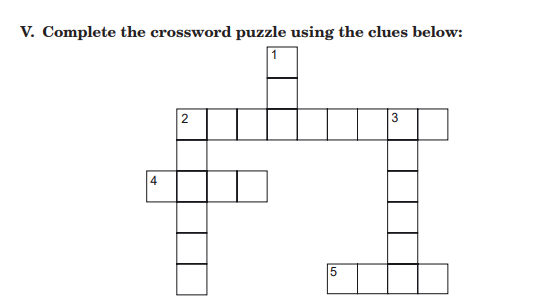General
UNIT 7: Air, Wind and Sound
Air is what everybody breathes. It is a mixture of gases.
A moving air is called wind. Air is the gaseous medium through which sound propagates.

Wave your notebook across your face.
What do you feel?

You will feel
 . Air is everywhere. We cannot see it. We can only feel it.
. Air is everywhere. We cannot see it. We can only feel it.

1. Take a deflated balloon.
2. Blow it until it increases in size.

What makes the balloon inflate? Explain why?
Air makes the balloon inflate. This is because the air blown into the balloon occupies space.
In the same way, air causes football and bicycle tubes to inflate. This shows that


1. Take two balloons of the same size.
2. Blow them up to the same size.

3. Tie their ends with string.
4. Now place these on the two pans of a beam balance. What do you observe?
5. Now burst one balloon and observe what happens.

Why does the pan that holds deflated balloon go up and the other end come down?
The inflated balloon goes down as it is heavy.
The inflated balloon is heavy because it has air in it.
This shows that the


1. Take a syringe.
2. Pull its plunger and draw in 10 mL of air.
3. Then cover its nozzle with your finger.

4. Try to push the plunger down.
What do you observe?
Why can you push the plunger into a certain
extent? Discuss.
Air inside the syringe gets compressed to a certain extent.
This shows that

Thus, the air has the following properties:
(a) Air occupies space
(b) Air has weight
(c) Air can be compressed

1. Take a beaker and fix a candle on it.
2. Pour water into it.
3. Mark the initial level of water.
4. Light the candle.
5. Cover the candle with a glass jar.
6. Record your observation.

The candle stops burning when it is covered by the jar.
It is because the burning candle has used up the oxygen present inside the jar.
Water rises up to fill this space.
The level of water rises to one-fifth of the glass jar.
This is because one-fifth of air is used up in the jar.
This shows that



Air has different components. Each component has some specific use. Some of them are:


1. Discuss the following questions in groups:
What would happen if there was no nitrogen in the air?
Write some other uses of nitrogen.
2. Make a report on it and present to the class.
If there was no nitrogen in air,
everything would burn rapidly on the earth surface.
Nitrogen prevents this rapid burning.
Nitrogen is also used in the preparation of fertilizers.


You will see that the cockroach in the second jar dies.
This is because the burning candle has used the oxygen present inside the jar.
Due to the lack of oxygen, the cockroach could not respire.
This shows that


1. Take two potted plants.
2. Keep them in the open.

3. Cover one of the plants with a bell jar.
What do you observe after 2-3 hours?
The plant covered with bell jar wilted.
This is because it got no oxygen for respiration.
The plant which was kept open did not wilt.
This is because it got oxygen for respiration.
This shows that


1. Take two flasks and label them A and B.
2. Put wet cotton cloths in both flasks.
3. Place equal number of soaked gram seeds
on the wet cotton wool in both the flasks.
4. Take two test tubes and tie them with threads.
5. In the first test tube,
fill Pyrogallic acid which absorbs oxygen. Hang this test tube in flask
A. Ensure that no acid falls on the cotton wool.
6. In the second test tube, fill water and hang this test tube in flask B.
7. Seal both the flasks with the corks and keep them in the room at ordinary temperature.
8. Observe them after two days.

You will find that seeds in flask B grow while seeds in flask A do not.
In flask A, oxygen was absorbed by the pyrogallic acid and no germination took place.
In flask A, there was oxygen and germination took place.
This shows that




The candle covered with the cup goes off after some time.
This is because the supply of oxygen is interrupted.
This shows that
 .
.Thus, oxygen is used for the following purposes:
Thus, oxygen is used for the following purposes:
(a) Respiration
(b) Plant germination
(c) Combustion



Argon is used in the light bulb.



1. What does the picture show?
2. What is the process called?
3. Which gas is used in this process?
This is the process of
 . In this process,
. In this process,green plants use carbon dioxide to prepare food.

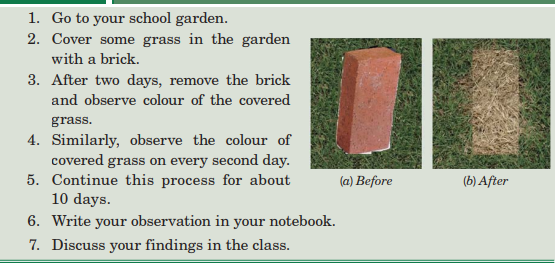
The grass covered with the brick cannot receive atmospheric carbon dioxide and light.
So it is unable to prepare its food and becomes pale yellow. This shows that



1. What does this picture show?
2. Why does the drink fizz up?
3. Which gas is used in its preparation?
In factory,
 .
.Carbon dioxide is poorly soluble in water.
When we open the bottle, carbon dioxide is quickly released. T
Therefore, releasing the pressure it produces fizz.

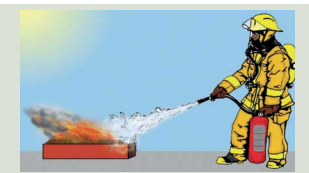
1. What does the picture show?
2. Which gas is used in the fire extinguisher?
Carbon dioxide is used in the fire extinguisher to put the fire off.
Thus, carbon dioxide has the following uses:
(a) Green plants use carbon dioxide to make their food.
(b) Carbon dioxide is used for
 like soda water.
like soda water. (c) Carbon dioxide is used in
 to put the fire off.
to put the fire off.
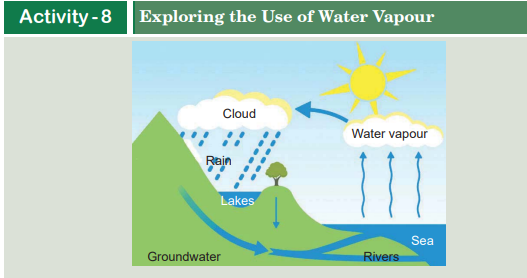
1. What does the picture show?
2. What is the role of water vapour in the process ?
The picture above shows the cycle of water.
Water vapour forms clouds and then falls as rain on earth.
So it is essential for life processes on earth.


The atmospheric air contains a little amount of carbon dioxide and water vapour.
These are the most powerful greenhouse gases.
Charcoal stoves, brick kilns,
factories and motor vehicles release carbon dioxide into the atmosphere.
Bushfire also increases the amount of carbon dioxide in the atmosphere.
This gas traps the heat released by the earth. As a result, the atmospheric temperature increases.
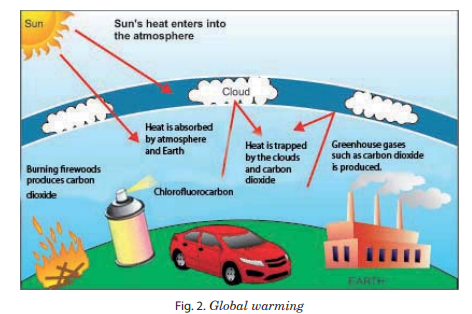
 is produced during boiling of water.
is produced during boiling of water. These vapours are suspended in the atmosphere as clouds.
These clouds trap the heat released by the earth. As a result,
the atmospheric temperature increases.
The process of rising atmospheric temperature is called


Carbon monoxide is a poisonous gas.

1. Take a small rat and keep it in the first jar.
2. Take another rat and keep it in the second jar.
3. Place a burning candle in the second jar.
4. Now cover both the jars with their lids.
What difference do you observe?
Explain why?

You will see that the rat in the second jar gets unconscious. This is because the burning candle fills the jar with carbon monoxide. It shows that carbon monoxide is dangerous.
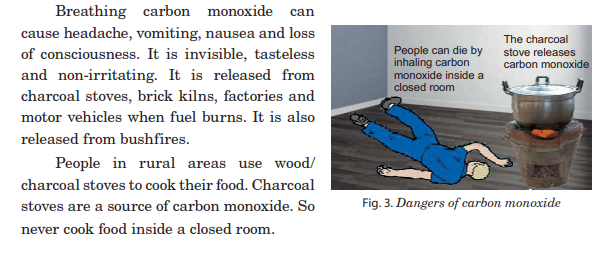

To prevent atmosphere from global warming:
1. Reduce fuel consumption.
2. Walk, use bicycle or take public transport.
3. Encourage people to plant trees to preserve the rainforests.
4. Use solar and wind energy.
5. Maintain your vehicle properly.
6. Turn off your vehicles at the traffic lights
. 7. Buy energy-efficient appliances.

Place a burning candle in your school verandah.
What do you observe?
What makes the candle flame disturbed?
Moving air disturbs the flame. This moving air is called

It blows from a particular direction.

1. Discuss what type of wind is blowing by looking out of the window.
Explain its nature also.
2. Each pupil lists the differences between the types of wind.
Movement of air depends on the change in pressure and temperature of
the atmosphere. Winds may be light, breezy or stormy


When wind blows very fast, it is called

A storm can uproot trees and blow away temporary houses.
It can also damage bird’s nests, sheds, and crops.
We must not go out of our homes during a storm.
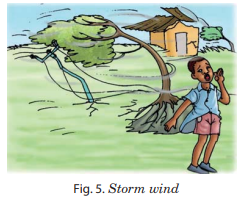

Air and wind help animals and human in many ways.


1. What does the picture show?
2. What helps the bird to fly?
Air helps the bird to fly in the sky.


You will feel uneasy. This is because air is necessary for breathing.


This process is called
 . Wind helps in winnowing.
. Wind helps in winnowing.In this process, farmers separate lighter
husk particles from heavier grains like corn, millet and sorghum.


After two hours, you will find the clothes become dry.
What make the clothes dry?
The moving air helps the clothes to dry.

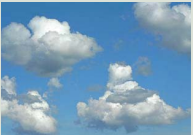 \
\1. What does the picture show?
2. What helps the clouds
to move for rain distribution?
The picture shows clouds formation,
moving air helps the clouds to move for rain
distribution.

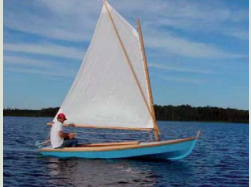
1. What does the picture show?
2. What helps the boat to sail on water?
Moving air helps the boat to sail on water.

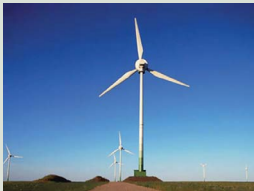
1. What does the picture show?
2. What helps the wheel of the windmill to rotate?
The moving air rotates the wheel of the windmill to generate electricity.

Air helps us in many ways. But sometimes it is very dangerous.

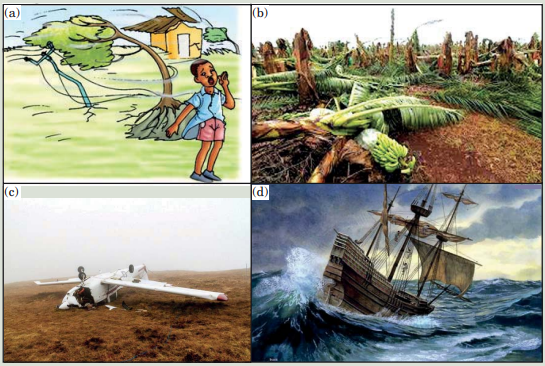
1. Observe the pictures above and state what is happening?
2. What do strong winds do to trees and electric poles?
3. How can strong wind damage houses and properties?
4. Why is it unsafe to fly an airplane on a stormy day?
5. Why is it unsafe to sail a boat on a stormy day?
The following are some dangers of wind:
1. Strong winds can uproot the plants and electric poles.
2. It can damage our houses and other properties.
3. It can damage our crops.
4. On a stormy day, an airplane can lose its control and may crash.
5. Strong wind can make a boat sink
Can you add some more dangers to this list ?

Organise a visit to an area spoiled by the wind.
Observe and list the effects of wind on environment

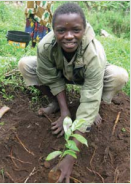
1. What does the picture show?
2. Why does the boy plant trees around his house?
The boy plants trees around his house.
Trees can block the wind speed and protect the house from damage.
We can prevent dangers of wind in the following ways:
1. Trim the branches of trees. It allows the wind to pass through.
It lowers the chance of trees tumbling over.
2. Ask the fishermen not to go for fishing on a stormy day.
3. Check the roof for loose tiles.
They can get displaced by strong wind and hurt some one.
4. Never go on a stormy day. You can get hurt.
5. Make people aware about the dangers of wind.


1. Go outside your classroom.
2. Try to hear different sounds produced in your surroundings.
3. List the sources of each sound, you have heard.
4. Imitate these sounds.
5. Ask your friend to tell what sound you are making.
Sound is a form of energy.
It comes from all around us.
It comes from:
people when they talk.
radios when they play.
airplanes when they fly.
Even breathing makes a low sound

Sounds may be soft or loud,
high or low, and pleasant or unpleasant.
Still, all kinds of sounds are made in the same way


When we hit the drum,
its membrane moves back and forth very quickly.
This fast movement is called

It makes the sound. The vibrations cause paper
pieces to jump on the membrane.


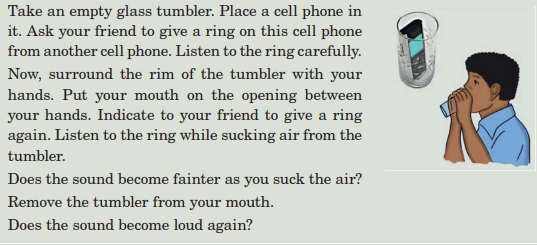
The sound becomes fainter as you suck the air.
This is because the air has been removed from the glass.
It shows that

It cannot travel in vacuum. Some other nature of sound are:
1. Sound is a form of energy, just like electricity and light.
2. It is always produced by a source.
3. Sound waves cannot be transmitted through vacuum.
4. Speed of sound varies in all three media.


You will feel vibration of the speaker.
Its back and forth movements make the sound propagate towards your ears.
Propagation means the transmission of sound in different states of matter.
When any object vibrates, it causes movement of the air particles.
These particles push the particles close to them.
It makes them vibrate too.
This movement creates sound waves.
If your ear is within range of the vibrations, you hear the sound.
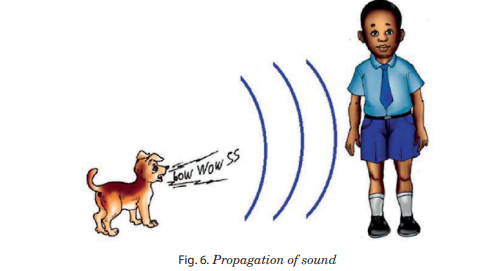
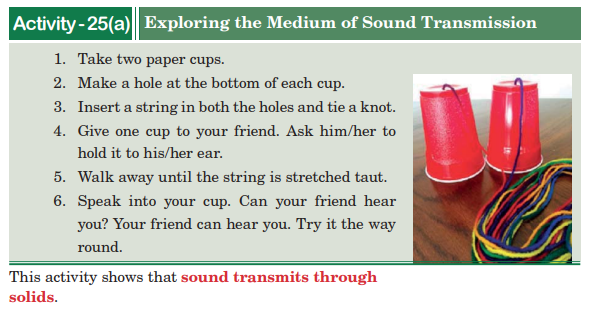

1. Go to your school playground.
2. Let each of you try to talk to each other.
Do you hear each other?
You hear one another. Here the


1. Take a bucket and fill it with water.
2. Take a small bell in one hand.
3. Shake this bell inside the water to produce sound.
Make sure that the bell does not touch the body of the bucket.
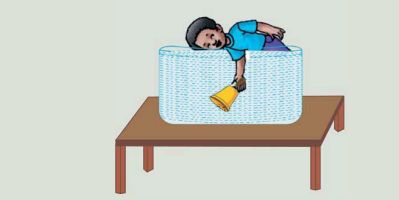
4. Place your ear gently on the water surface. Be careful:
water should not enter in your ear.
Can you hear the sound of the bell?
You can hear the sound of the bell.
This shows that


Thus, sound can transmit through the following:
Thus, sound can transmit through the following:
(a) Solids
(b) Airs
(c) Liquids

1. Move towards a hilly area.
2. Shout loudly. What do you hear after a while?
A faint sound similar to original sound is heard after some time.
This can also be experienced in big and empty rooms or halls.
Sound hits the solid surface and reflects back.
This reflection of sound waves is called




1. Take a tuning fork and strike it with a hard object (Figure
A). Hear the sound it produces.
2. Now take a hammer and strike it on a metal box (Figure
B). Hear the sound it produces.
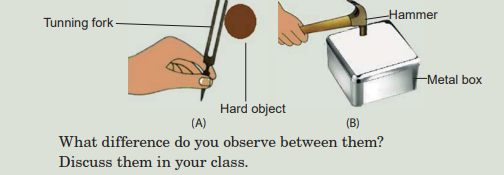
We hear different types of sound in our daily life.
Some of them are pleasant to hear.
Others are unpleasant to hear.
The sounds which are pleasant to hear are
 .
. Musical sounds are produced by the regular vibrations.
All musical instruments produce regular vibrations,
for example, strings of guitar and violin.
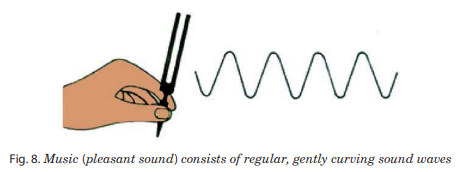
The sounds which are unpleasant to hear are called
 .
. Irregular vibrations produce noise. Grinding machine, hammer,
motor vehicles and crackers produce irregular vibrations.


1. Visit a nearby factory or a stone crusher.
What type of sound does it produce?
2. List some effects of such sounds on our health and environment .
We hear sound or noise through our ears.
If we hear loud noise, we get irritated.
Prolonged exposure to noise has various harmful effects.
1. Loud noise can damage our ears.
2. Loud noise can also cause
 .Tinnitus is like a ringing or buzzing
in the ears or head.
.Tinnitus is like a ringing or buzzing
in the ears or head. 3. Noise leads to emotional and behavioural stress.
4. Noise increases chances of diseases like headache, blood pressure and heart failure.
5. Noise leads to noise pollution.


1. What does this picture show?
2. Why is the factory worker wearing earmuffs?
The factory worker is wearing earmuffs to protect his ear from noise.
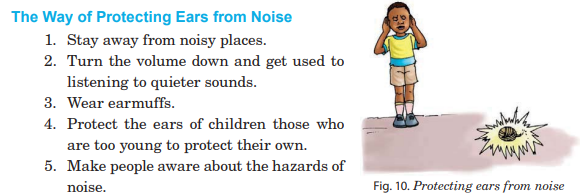

Air : mixture of gases.
Combustions: The process of burning a substance,
Such as charcoal and wood, in the presence of oxygen.
Echo: The reflection of sound waves.
Germination : The process by which a plant grows from a seed.
Global warming : The process of rising atmospheric temperature.
Green house : A glass housing in which temperature can be regulated to grow plants.
Photosynthesis : The process through which green plants produce their food.
Respiration : The process by which energy is obtained from food.
Sound : A form of energy, just like electricity and light.
Sound propagation: The transmission of sound.
Syringe :A tube with a nozzle for sucking in and ejecting liquid in a thin stream.
Tinnitus : Ringing or buzzing in the ear.
Vibration : To and fro movement of something.
Wind : The moving air.

Air is a mixture of various gases.
It has the following properties:
(i) It occupies space.
(ii) It has weight.
(iii) It can be compressed.
Oxygen is used by all living things.
It is essential for germination, respiration and combustion.
Carbon dioxide is an essential component of photosynthesis.
Green plants use carbon dioxide to make their food.
Carbon dioxide and water vapour are the most powerful greenhouse gases.
The moving air is called wind. Winds may be light, breeze and stormy.
Sound is a form of energy.
Propagation means transmission of sound in different states of matter.
The reflection of sound is called echo.
The sounds which are pleasant to hear are pure or musical sounds.
Musical sounds are produced by the regular vibrations.
The sounds which are unpleasant to hear are called noise.
Irregular vibrations produce noise.

Do these review exercises in your exercise book.
1. The percentage of nitrogen present in air is ............. .
(a) 78% (b) 21% (c) 0.17% (d) none of these
2. …………….. supports combustion.
(a) Oxygen (b) Argon (c) Nitrogen (d) Water vapour
3. …………. is a greenhouse gas.
(a) Oxygen (b) Carbon dioxide (c) Argon (d) None of these
4. …………. is used in light bulbs.
(a) Oxygen (b) Argon (c)Nitrogen (d) Water vapour
5. …………. is produced when something vibrates.
(a) Sound (b) Light (c) Air (d) Oxygen
II. State whether the following statements are true or false :
1. The vibrating body causes the medium around it to vibrate.
2. Nitrogen is essential for respiration.
3. Reflection of sound waves is called echo.
4. Regular vibrations produce noise.
5. Noise increases chances of diseases
like blood pressure and heart failure.
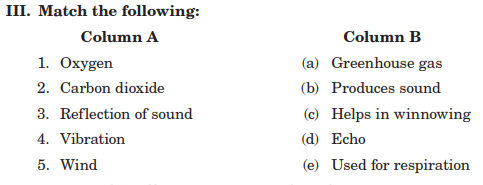
v. Answer the following question briefly
1. List different properties of air.
2. Explain the composition of air.
3. List at least two uses of the following:
(a) Oxygen (b) Carbon dioxide
4. List the main types of wind.
5. State some uses of air and wind.
6. Define echo.
7. What is the nature of sound wave?
8. How can we protect our ears from noise?
